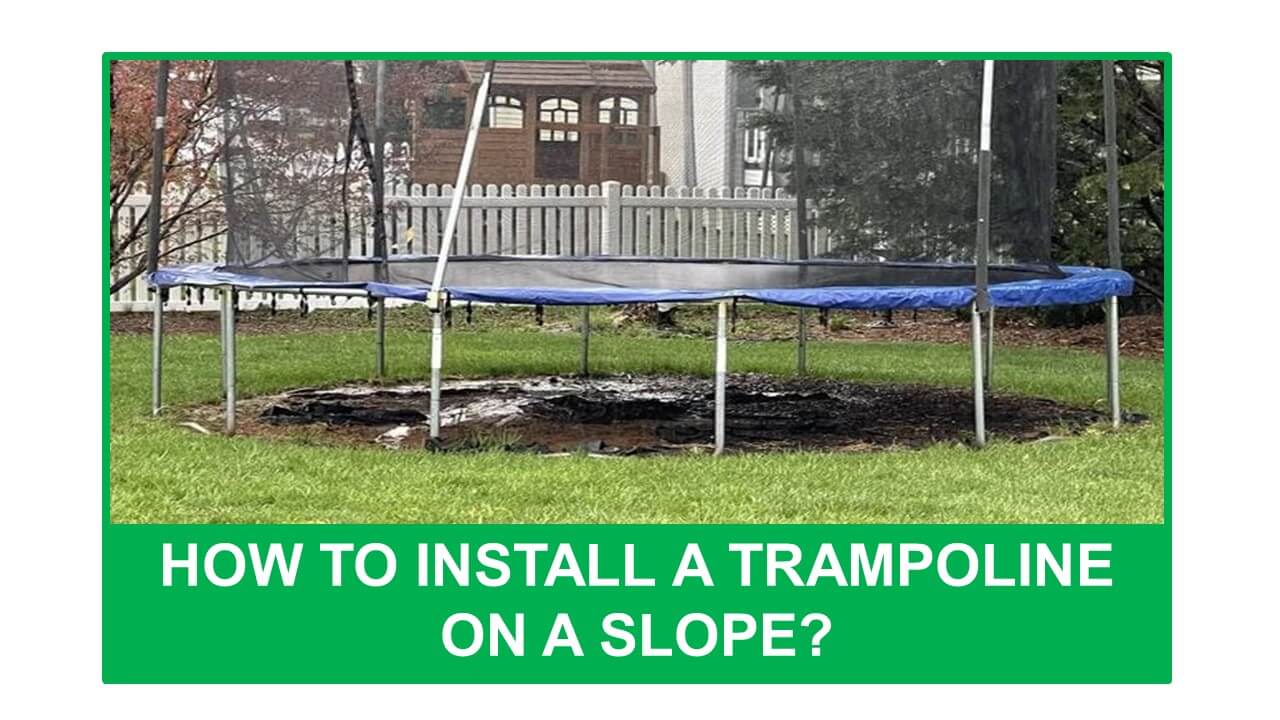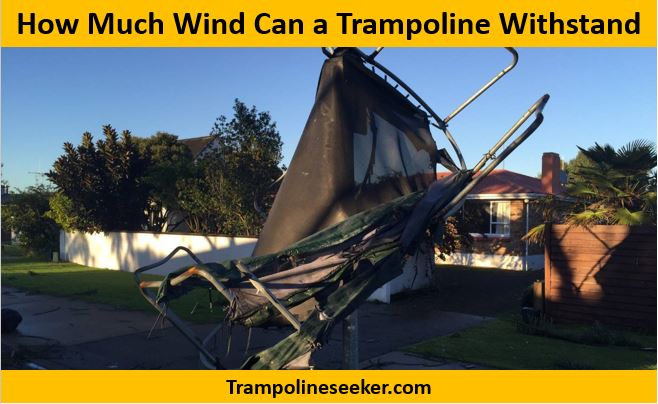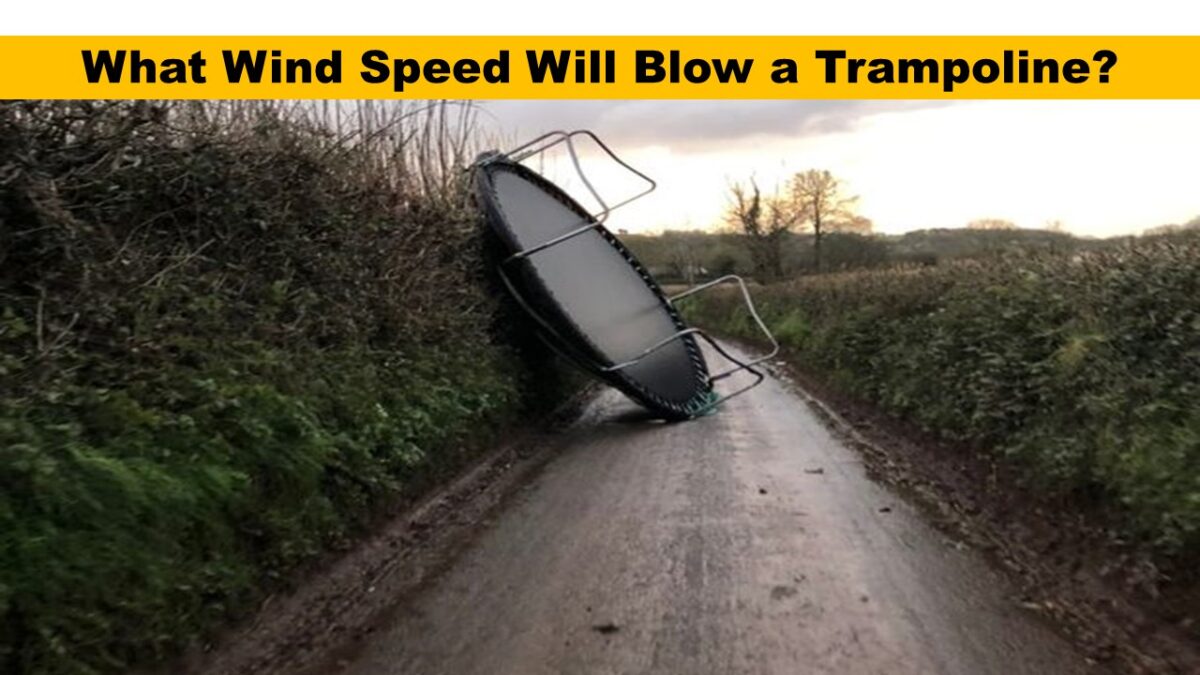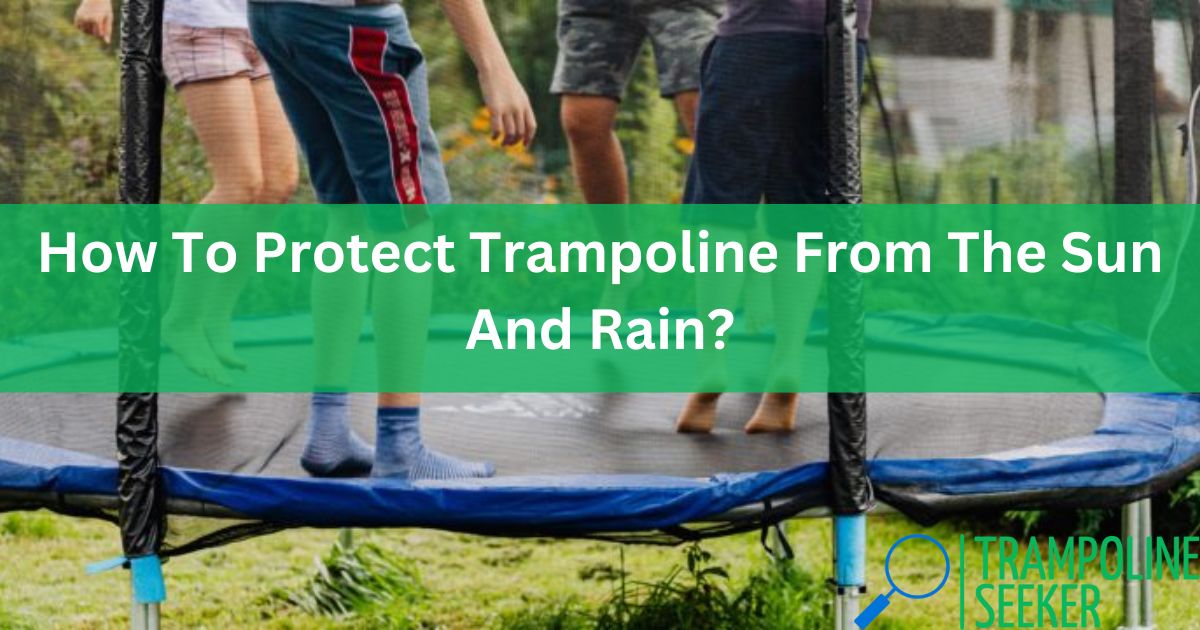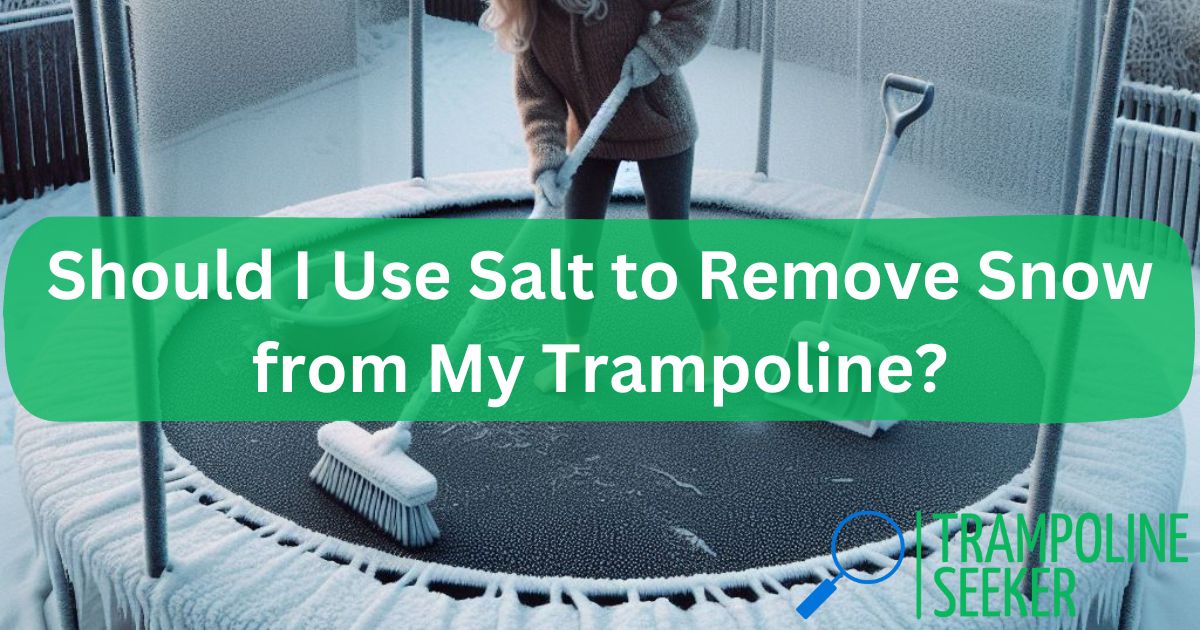The short answer is no, you should not jump on a trampoline that has any size hole or tear in the jumping mat. Even small holes can expand, damaging the mat further and potentially causing injury. However, depending on the hole’s location and size, repair may be an option before continuing to use the trampoline safely.
When a hole develops in the heavyweight, tightly-woven mesh material that makes up a trampoline jumping surface, it strained the surrounding fabric. The continuous force placed on a damaged area with each bounce stresses it exponentially, causing holes and tears to expand rapidly.
As holes widen, injury risks heighten should jumpers fall through or springs detach. Still, well-placed patches can effectively reinforce damaged spots, and punctures under 2 inches wide typically respond well to at-home repair techniques using widely available trampoline patch kits.
Dangers of Jumping on Trampolines With Holes
Jumping on trampolines with any size holes poses multiple risks both to jumpers and equipment integrity. The three main concerns center on the mat further tearing, springs breaking or detaching, and the frame or other components bending from imbalanced tension distribution.
Expanding Tears
Even if a hole seems tiny initially, the extreme opposing forces placed on the surface fabric with each bounce will pull at compromised areas. This consistent stress causes holes and tears to expand rapidly across formerly undamaged sections of mat. Should a substantial tear or hole form below a jumper, falling through becomes highly likely and can lead to anything from bruises to broken bones.
Spring Tension Imbalance
On trampolines, springs connect the jumping surface to the frame using an intricate network of V-rings and holders. This system keeps the mat taut. Holes and tears interfere with even tension distribution, overloading some springs while others fall slack. Loose springs may unhook and fly off, while excess tension can snap springs entirely or tear V-ring stitching. Airborne springs and unsecured mat edges increase injury potentials.
Frame and Connection Damage
When part of the interconnected trampoline loses integrity, pressure redistributes unevenly across remaining areas. The imbalanced forces placed on frame joints, bolt connections and mat edges can progressively damage components. Continued stress may bend or buckle the frame. Compromised joints loosen further, and additional tears form elsewhere in the mat as unhealthy tension mounts.
Repairing Small Holes and Tears
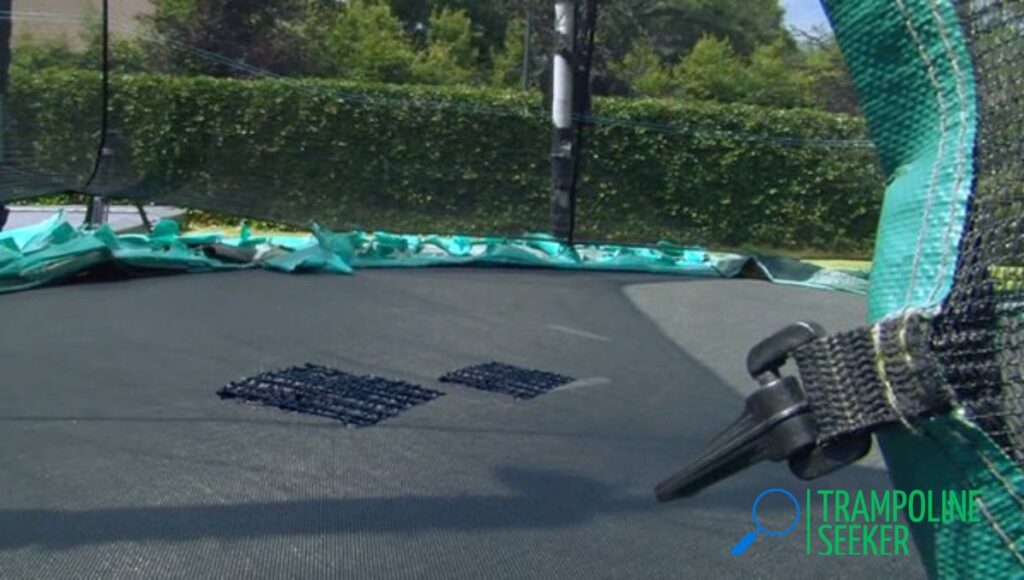
Trampoline manufacturers recognize that jumping mats sustain wear over time. Most include patching materials with new units explicitly for damage control. For already owned trampolines, DIY kits are readily available containing everything needed to reinforce damaged spots properly. Typically, holes smaller than 2 inches respond extremely well to at-home patching techniques using these specially designed remedies.
Patch Kit Types
Trampoline patch kits generally utilize either adhesive or sewing repair solutions. Both perform well when applied correctly to holes meeting size and placement qualifications. Most kits accommodate multiple repairs, contain full instructions, and cost under $20.
Adhesive Patches
Appropriately sized fabric patches with strong adhesive backs comprise one variety of repair kit. They stick firmly to cleaned and properly prepared mat surfaces. Some feature waterproof silicon texture on the jumping side to help patches withstand friction and exposure while providing ample grip.
Sew-On Repair Patches
These repair aids include heavy-duty patches and UV-resistant threading for stitching damages. Hand-sewing with the thick needle and nylon threads offered achieves a tight, durable bind between patch and original mat materials. Many kits suggest mastering a basketweave pattern and using numerous stitches along tear edges for optimal longevity.
Must Read: How to Fix a Hole in a Trampoline?
When to Attempt Trampoline Hole Repairs Yourself
While it depends partially on personal aptitude, holes smaller than 2 inches located away from mat edges typically respond extremely well to DIY patching techniques. Either adhesive or sew-on options applied correctly reinforce the surrounding area enough to prevent additional tearing. However, extensive damage or borderline placements may require professional intervention.
Holes Appropriate for DIY Repairs Meet the Following Criteria:
- Under 2 inches diameter
- At least 2 inches from any mat edge
- Free of fraying or gnarling along sides
- If preexisting, show no signs of expansion since first appearing
Larger holesover 2 inches wide, tears longer than 3 inches, damage along mat hems, or holes displaying fraying should undergo inspection by a professional installer to determine if patching constitutes an appropriate remedy. Trampolines experiencing structural damage beyond mat tearing require more extensive repairs as well.
Patching Kit Instructions
Both adhesive and sew-on trampoline patch kits provide detailed application directions tailored to their specific products with each purchase. However, best practices applicable to either typically include:
Preparing the Damaged Area
- Clean debris from the hole so patch adheres well
- Scuff glossy vinyl with included abrasion tool Applying the Patch
- Center patch over damage without stretching or pulling
- Smooth out any bubbles or wrinkles in the fabric
Securing the Patch - Allow full adhesive curing time
- Use recommended stitch type and density
Re-establishing proper, uniform tension across the surface constitutes the final recommended step for DIY trampoline hole repairs. This may require adjusting multiple springs to achieve an evenly taut mat across all connection points.
CAUTION: Trampolines with existing structural defects, missing parts, loose bolts, severely bent frames or dangerously stretched springs should be fully repaired by professionals or replaced before allowing further use.
How Long Does a Trampoline Patch Last?
When applied according to specifications, trampoline repair patches stand up remarkably well to friction, sun exposure, moisture and continual impact. Both adhesive and sewn patches reinforce tears effectively for extended periods, often years. However, as with the original mats themselves, patch durations depend largely on trampoline use frequencies and UV exposure levels. Those in constant use or left uncovered outdoors age faster. With appropriate care, a properly patched trampoline lasts for many additional happy bouncing sessions.
Table Summarizing Trampoline Patch Longevity:
| Patch Use Frequency | Estimated Longevity |
| Heavy Use | 1-2 years |
| Moderate Use | 3-4 years |
| Occasional Use | 5+ years |
Conclusion
Jumping on a trampoline with any size hole risks bodily harm resulting from widening tears, detached springs or collapsing supports. Still, through proper patching, smaller damaged areas become entirely safe for continued bouncing fun. For best outcomes, repairs should use materials designed specifically to reinforce trampoline surfaces, and holes should fall below the 2-inch maximum suggested for DIY intervention. Appropriate care extends patched trampoline lifespans indefinitely. So next time a tiny trouble spot pops up, don’t despair. Just patch properly and bounce happily on!
Related Trampoline Patch FAQs
How do I know if a trampoline hole needs professional repair?
Consult an authorized trampoline service professional if holes or tears exceed 2 inches, reside along mat edges, display fraying or other signs of deterioration, or relate to structural issues beyond mat damage. The experts can best determine if DIY patching suffices or more complicated remedies become necessary in severe instances.
Is it safe to jump near a patched trampoline hole?
Yes, as long as you apply patches precisely according to kit instructions, the reinforced area regains its former durability. Patched holes smaller than 2 inches located away from mat sides withstand focused impact equally well across the entire jumping surface. However, it remains important to rebalance tension properly across all springs before continuing use after any trampoline repair.
How do I find the right trampoline hole patch kit?
Reputable brands offering repair materials specifically engineered for trampoline mat fabrics include Protecto Wrap, Gold Medal, and Skywalker Options. Or check with your trampoline’s manufacturer – most include patching kits with new units or sell compatible spare parts on their websites. Select a kit size suited to your damage that contains either adhesive or sew-on patches based on your personal preference and skill level.
Can I patch a trampoline hole in cold weather?
The adhesives on patch kits require temperatures of 65°F or warmer during application and curing. If attempting repairs in cold weather, move the trampoline to a heated area like a garage until patches set fully to ensure optimal bonding strength. Sew-on patches, however, work equally well across all temperatures. So in frigid conditions, opt for a stitch-in reinforcement kit instead.
Articles You May Like to Read:


